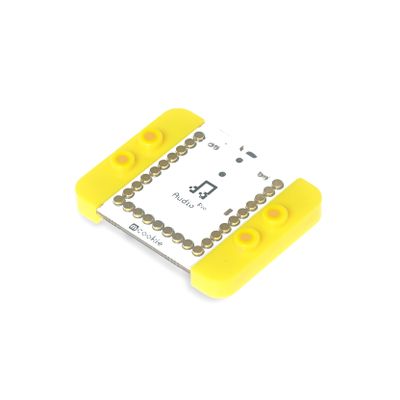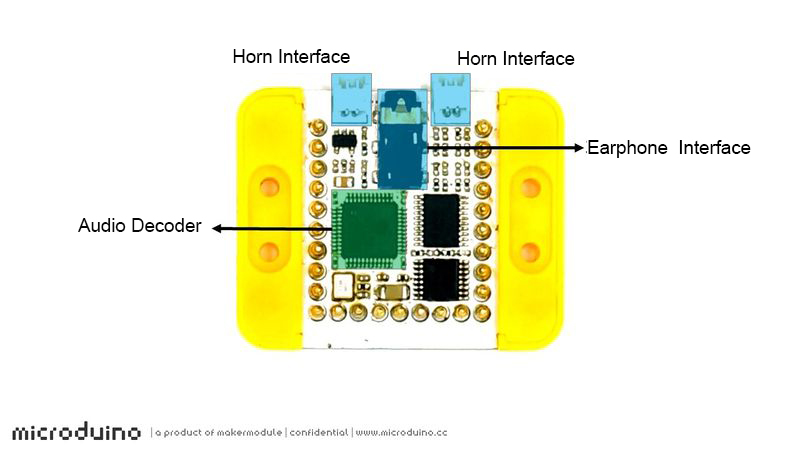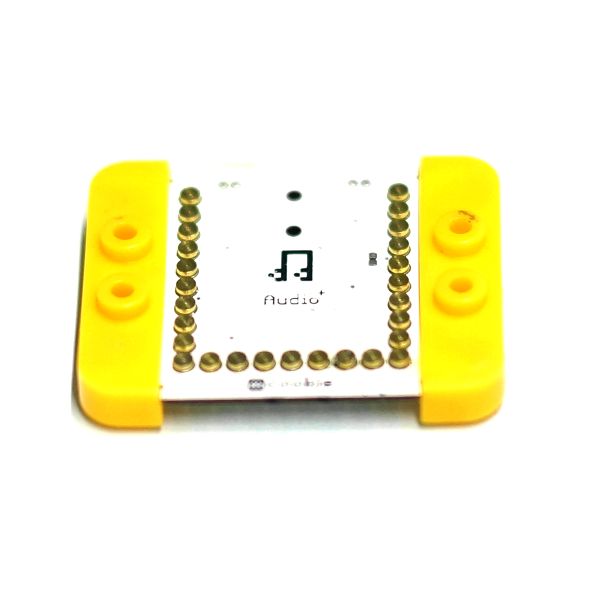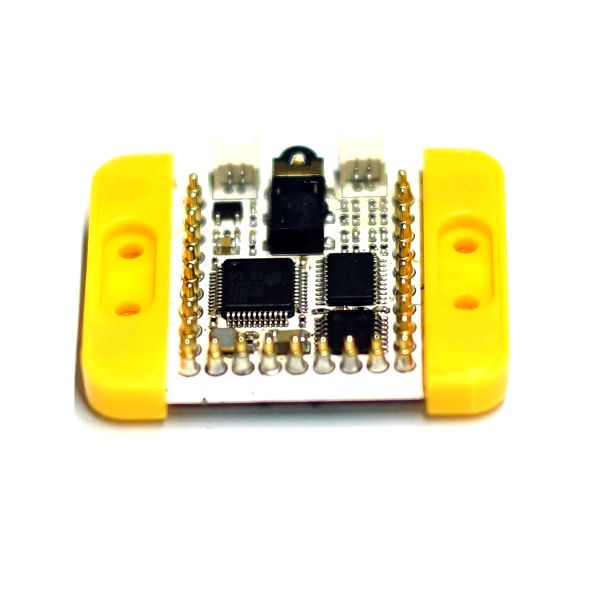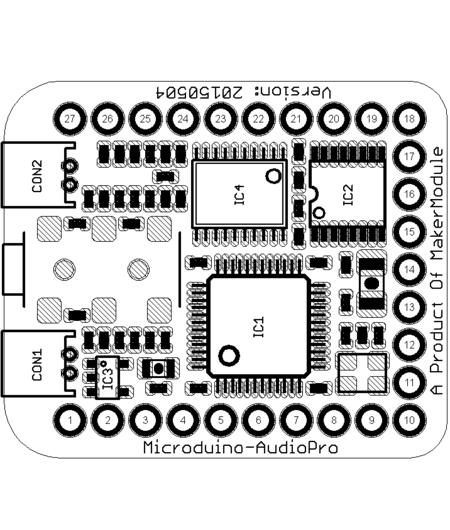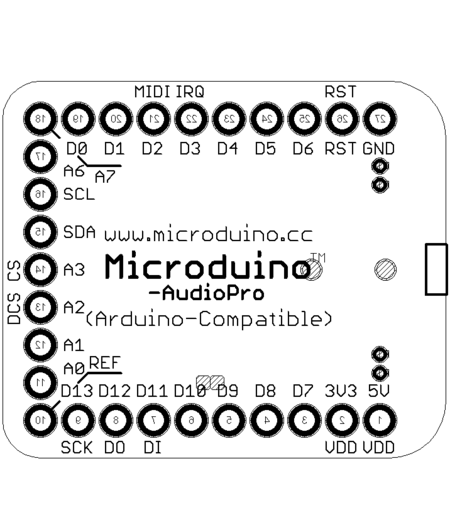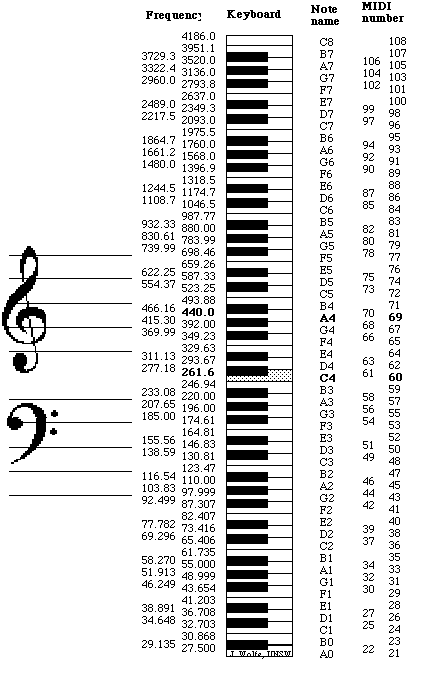|
mCookie-AudioPro是以VS1053为解码器,集成2.2W立体声功放,并且支持2.5mm立体声耳机接口的多功能音频模块,支持MIDI功能
特色
- 多种格式的解码支持:MP3/WMA/AAC/WAV/Ogg Vorbis/MIDI
- 可实时模拟多达128种MIDI乐器
- 集成2.2w立体声功放
- 板载2.5mm立体声耳机接口
- 耳机/外放自动切换功能
- SPI高速通信接口
- 小巧、便宜、堆叠、开放;
- 开源的硬件电路设计,与 Arduino 兼容的编程开发环境程;
- 统一的 Microduino 接口规范,和丰富的外围模块,可方便、灵活的与其他符合 Microduino 接口规范的模块、传感器进行快速的连接和扩展;
- 2.54间距的排母接口方便集成到洞洞板。
规格
- 多种格式的解码支持:MP3/WMA/AAC/WAV/Ogg Vorbis/MIDI
- 可实时模拟多达128种MIDI乐器
- 通用的MIDI和SP‐MIDI格式0文件是能播放的,而格式1和2文件必须由用户自己转换成0格式的
- 最多的复音数为64,而最大持续的复音数是40
- 集成2.2w立体声功放(LM4863)
- 板载2.5mm立体声耳机接口
- 耳机/外放自动切换功能
- 18比特超采样率的(oversampling)、多比特的、sigma‐delta型高精度DAC
- 超采样率oversampling一般是指超过标称采样率整倍数的更高采样率,常用来提高采样精度。这里是指还原数码声音时,用标称采样率数倍的采样率输出,可以使音频的阶梯陡变趋于平缓,降低数字背景噪音和减小失真,从而获得超过原采样率输出效果的高质量音频
- 电气特性
- VS1053:3.3V,30~60mA
- LM4863:5V,1A
引脚说明
- D2引脚为实时MIDI接口
- 实时MIDI默认不启用,如需启用,将模块背面的跳线短接即可
- 启用实时MIDI以后,UART的波特率应为31250bps,此时SPI接口将不可用
| AudioPro模块引脚名 |
Microduino引脚 |
功能
|
| SCK |
D13 |
SPI总线时钟
|
| SI |
D12 |
数据输入脚
|
| SO |
D11 |
数据输出脚
|
| CS |
A3 |
SPI片选信 (程序中需要定义)
|
| DCS |
A2 |
数据/命令模式选择 (程序中需要定义)
|
| DERQ |
3 |
中断输出 (程序中需要定义)
|
| MIDI |
2 |
MIDI输入 (默认不启用)
|
文档
开发
- 你可以通过_06_Microduino_AudioPlus_VS1053库进行功能测试:github
- 相关示例程序下载:github
- 其中Audio_MIDI是SPI接口通过加载补丁实现实时MIDI的例程
- 其中Audio_ROM是播放ROM中音频文件的例程
- MIDI的资料见附录
- 音频文件转16进制工具:文件:DataToHex.zip
应用
音频MIDI
图库
MIDI numbers,Note names and frequencies
可参考:NUSW
|
|
- Note names, MIDI numbers and frequencies are related here in tables and via an application that converts them. The musical interval between two notes depends on the ratio of their frequencies.
- An octave is a ratio of 2:1 and, in equal temperament, an octave comprises 12 equal semitones. Each semitone therefore has a ratio of 21/12 (approximately 1.059). By convention, A4 is often set at 440 Hz. These data were used to calculate the first table below, which gives the frequency of any standard keyboard note or MIDI note number. To convert from any frequency to pitch (i.e. to the nearest note and how far it is out of tune).
- This table is reproduced inverted below, i.e. with high pitch at the top.
- To convert from any frequency to pitch (i.e. to the nearest note and how far it is out of tune, go to the frequency to note converter written by Andrew Botros.
- How to do the caluation? Suppose thattwo notes have frequencies f1 and f2, and a frequency ratio of f2/f1. An octave is a ratio of 2:1, so the number of octaves between f2 and f1 is
- Now to divide the octave into smaller units. In equal temperament, where all semitones have the same frequency ratio of 21/12, conversion between note name and frequency is simple. First, one needs a reference note and frequency. This is usually A4, which is often set at 440 Hz. For a note that lies n semitones higher (or −n semitones lower), the frequency is then
- Conversely, one can obtain n, the number of semitones from A4, from
- Similar equations give no, the number of octaves from A4, and nc, the number of cents from A4:
- no = log2(fn/440 Hz) and nc = 1200*log2(fn/440 Hz).
- In electronic music, pitch is often given by MIDI number: let's call it m for our purposes. m for the note A4 is 69 and increases by one for each equal tempered semitone, so this gives us a simple conversion between frequencies and MIDI numbers (again using 440 Hz as the pitch of A4):
- m = 12*log2(fm/440 Hz) + 69 and fm = 2(m−69)/12(440 Hz).
- The notation used here is not universal: in German speaking countries, H is used instead of B, and B is used for Bb. (This allowed Bach to write his name in the Art of Fugue.) And of course when different tuning systems are used, different names are applied.
|
MIDI旋律乐器组(GM1)
MIDI打击乐器组(GM1+GM2)
- 27-High Q-电子乐中的按钮声
- 28-Slap-拍打声
- 29-Scratch Push-特效处理推音
- 30-Scratch Pull-特效处理拉(勾)音
- 31-Sticks-鼓棒敲击声
- 32-Square Click-敲方板
- 33-Metronome Click-节拍器击打
- 34-Metronome Bell-节拍器铃声
- 35-Acoustic Bass Drum-原声大鼓(低音大鼓)
- 36-Bass Drum 1-大鼓1(低音鼓)
- 37-Side Stick-敲鼓边
- 38-Acoustic Snare-原声小鼓(军鼓、小鼓)
- 39-Hand Clap-拍手
- 40-Electric Snare-电子小鼓(电子军鼓)
- 41-Low Floor Tom-低音落地筒鼓
- 42-Closed Hi-Hat-闭合踩镲(闭合双面镲)
- 43-High Floor Tom-高音落地筒鼓
- 44-Pedal Hi-Hat-踩镲(踩镲双面镲)
- 45-Low Tom-低音筒鼓
- 46-Open Hi-Hat-开放(双面)镲
- 47-Low-Mid Tom-中低音筒鼓
- 48-Hi-Mid Tom-中高音筒鼓
|
- 49-Crash Cymbal 1-镲击(吊镲)1
- 50-High Tom-高音筒鼓
- 51-Ride Cymbal 1-高架镲1
- 52-Chinese Cymbal-中国镲
- 53-Ride Bell-悬挂钟玲
- 54-Tambourine-铃鼓、小手鼓
- 55-Splash Cymbal-侧击镲、溅开镲声
- 56-Cowbell-牛铃、颈铃
- 57-Crash Cymbal 2-镲击(吊镲)2
- 58-Vibraslap-颤击
- 59-Ride Cymbal 2-高架镲2
- 60-High Bongo-高音邦加鼓
- 61-Low Bongo-低音邦加鼓
- 62-Mute Hi Conga-闷音高音康加鼓
- 63-Open Hi Conga-开放音高音康加鼓
- 64-Low Conga-低音康加鼓
- 65-High Timbale-高音定音鼓
- 66-Low Timbale-低音定音鼓
- 67-High Agogo-高音撞铃(拉丁打铃)
- 68-Low Agogo-低音撞铃(拉丁打铃)
- 69-Cabasa-卡巴沙铃(珠铃)
- 70-Maracas-砂槌(砂铃)
|
- 71-Short Whistle-短口哨
- 72-Long Whistle-长口哨
- 73-Short Guiro-短音刮板(短锯琴、短梗笛)
- 74-Long Guiro-长音刮板(长梗笛)
- 75-Claves-音棒
- 76-Hi Wood Block-高音木鱼
- 77-Low Wood Block-低音木鱼
- 78-Mute Cuica-闷音鸟鸣桶(短笛)
- 79-Open Cuica-开音鸟鸣桶(短笛)
- 80-Mute Triangle-闷音三角铁(三角铃)
- 81-Open Triangle-开音三角铁
- 82-Shaker-摇筛(振动筛)
- 83-Jingle Bell-门铃(信号铃、铃铛)
- 84-Bell Tree-铃树(树铃)
- 85-Castinets
- 86-Mute Surdo-闷音苏多鼓
- 87-Open Surdo-开音苏多鼓
|
|
